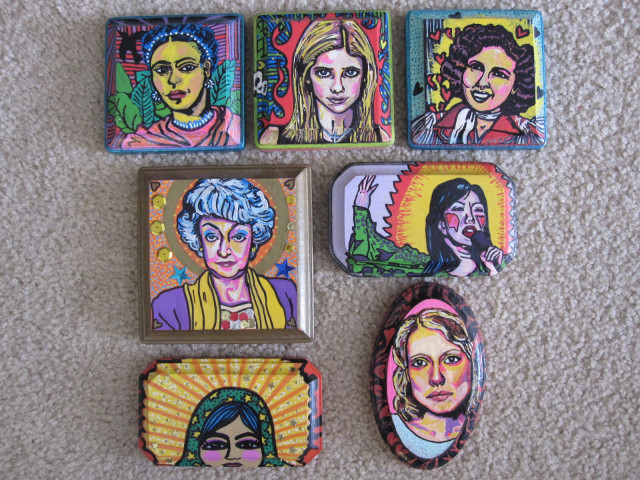Ms. March

Well, it’s March, that month that’s known for its infamous Ides, basketball “Madness” and hedonistic holidays, but it’s also the time for commemorating Women’s History. And, dear readers, though I love drinking shamrock shakes and eating paczkis while building my brackets and keeping my back knife-free, I’m first and foremost a woman (W-O-M-A-N) this month and every month, so I’m giving credit where credit’s due and giving it up for the ladies.
My friend Micha shared The Guardian’s Top 100 Women list on Facebook along with the challenge to “list women who have been inspirational in your own life in the comments below or in your own post.” I’m taking up that challenge in Idler style while also extending it to you (please share in the comments or on the platform of your choice).
So, here are a few women I admire whom I’d like to share with you:
 Meg Murray from Madeleine L’Engle’s A Wrinkle in Time series
Meg Murray from Madeleine L’Engle’s A Wrinkle in Time series
This inspiration is a 2 for 1 deal as the character and the writer were both very important to me. L’Engle gave me a smart, frizzy-haired, math wiz protagonist who didn’t believe in herself and thought she was ugly. Someone a lot less like a Disney princess and a lot more like me (minus the math business). Now here’s the even crazier part: she never gives Meg a makeover (at least not the kind where Sephora is involved). It’s almost as though she’s suggesting our heroine doesn’t need one. I know, right? Gasp squared.
Instead of becoming a super hottie magical princess, Meg struggles, thinks and pains her way through a journey in which she almost dies, but ultimately saves her father (not to mention the world!) from an inky evil out to erase imagination, creativity and love. L’Engle creates a real girl with real insecurities, a girl haunted by the fear that she isn’t enough and then chapter by chapter she lets her learn her power. Though Meg is the hero who saves the day, she’s also the kind of leader who understands that she is part of a team and an even larger, more complicated universe. This book and those that follow it in the series shy away from the typical masculinist constructions of hierarchical power and instead stress the importance of opening up, sharing and making oneself vulnerable to others as processes that do not weaken, but rather enrich and embolden the self.
This was the first book I stayed up past bedtime to read in secret snatches, shadows on the pages. This was the book that made child-me want to be a writer.
All this plus time travel? Madeleine L’Engle, you rock my world.
 Frida Kahlo
Frida Kahlo
Now, Frida, I’m embarrassed to admit, I didn’t meet until much later. In my first year of Spanish at the University of New Mexico we were learning the names for various parts of the face en espańol, por supuesto. Our T.A. pointed to her eyebrows and said, “Cejas. ¿Como Frida Kahlo? ¿Una ceja?” Then she held up a picture of this mesmerizing one-browed woman who also helped us learn that “bigote” means “mustache.” It was amor at first sight.
Frida’s work seems dangerous to me. It creates meaning baldly; it is unapologetically self-driven and self-concerned without being narcissistic. She paints herself to know herself. She paints herself because she is at once what she knows best and what she doesn’t understand at all. Bleeding onto the canvas, she shares her most personal moments, her body’s failures, her most physical pain and most surreal heartache. I love that she deals with what she fears and detests about herself and her surroundings not by hiding or avoiding, but by depicting it at its most abject. I adore that she takes what’s coded weak/feminine (emotion, self-reflection, relationships) and she showcases their power and wields that power with gusto.
I always struggle with my “I.” My I doesn’t make sense scientifically or logically and thinking about my I all the time makes me conceited, shallow, a bad person. Likewise, I always struggle with my artist’s eye. It sees the world in flat cartoonish shapes and colors—it does not represent with photo accuracy and it draws the same subjects over and over and over. Frida helps me love my I’s. She helps me love my eyes.
There are soooo very many more women that inspire me from Jane Goodall and Lisa Simpson to Dolores Huerta, Joan of Arc and Margaret Cho. And then of course there are the flesh and blood, even realer(?) women who populate my life and/or compose the twisting branches of my family tree. Friends, teachers, mothers, grandmothers, aunts, inventors, comedians, writers and chefs. . .
Women that dot my Facebook, women that make the news or speak it or analyze it.
I propose we make March much longer, extend its reach far into the summer, deep into the year and beyond. Let’s share these conversations/inspirations, daily, weekly, proudly, meekly, until the words of our stories wrap ‘round and fold back into the inspirations that we become.

The paintings above are idols of the women in pop culture who inspire and empower me. From top left clockwise: Frida Kahlo, Buffy Summers, Patsy Cline, Margaret Cho, Anya Jenkins (from Buffy), the Virgen de Guadalupe and Bea Arthur.